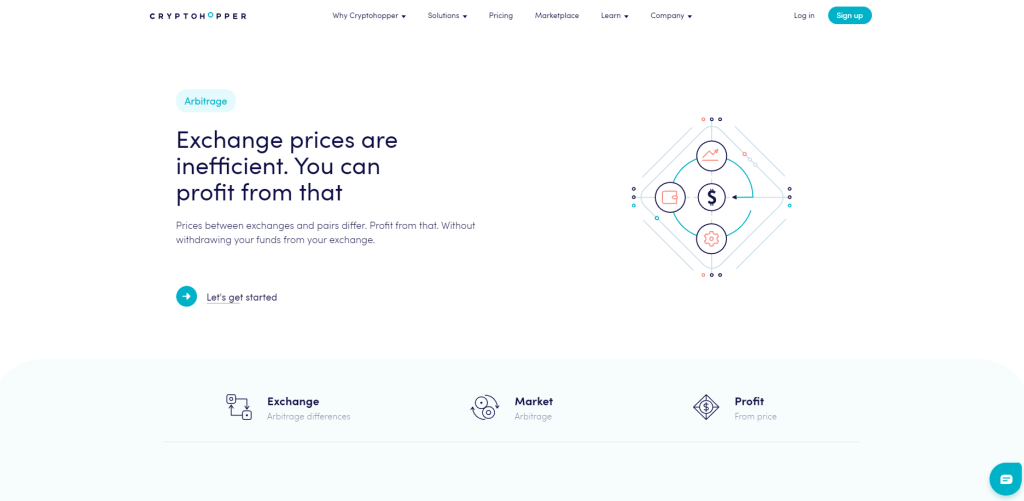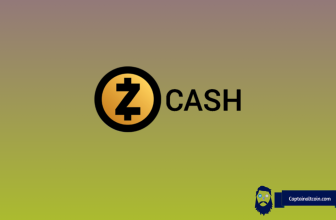Cryptohopper Arbitrage Bot Review – Guide on Cryptohopper Arbitrage Strategies

Many traders are on the lookout for tools that can give them an edge. Enter Cryptohopper: a platform that has garnered attention for its unique arbitrage features. Our Cryptohopper arbitrage review delves deep into its capabilities, shedding light on its effectiveness and efficiency. Whether you’ve heard of Cryptohopper arbitrage before or are just coming across it now, this review promises to offer a comprehensive look at what it brings to the table.
Arbitrage is defined by Investopedia as “the simultaneous purchase of one security and the sale of another security at a different price.”
Arbitrage is a type of trading strategy that exploits price differences between different markets. It is a form of risk management that allows traders to profit from small price differences across multiple markets. Arbitrageurs are often referred to as “the masters of the universe” because they are able to make money from seemingly insignificant price differences.
| 📜 Content | Details |
|---|---|
| 💰 Pricing | – Cryptohopper’s Arbitrage Bot requires an Adventurer subscription for Exchange Arbitrage and Market Arbitrage. A Hero subscription is needed to run Market Arbitrage, priced at $83.25/month if billed annually. |
| 📋 Features | – Exchange Arbitrage: Trade discrepancies between the same pairs on multiple exchanges. Market Arbitrage: Looks for market inefficiencies within a single exchange. It tries to increase the amount of coins you have selected as quote currency through three different trades. |
| 👍 Pros | – Easy to setup. A lot of documentation available for users. |
| 👎 Cons | – Steep learning curve: While it sounds good in theory, it might be challenging for beginners. Slow speed for market arbitrage: There are faster and more powerful private bots available in the market. |
What you'll learn 👉
Setup Guide Exchange/Market Arbitrage
Cryptohoppers Arbitrage Bot allows you to trade discrepancies between the same pairs on multiple exchanges.
There are two kinds of arbitrage you can do via the Cryptohopper platform: exchange arbitrage and market arbitrage.
You need an Adventurer subscription in order to exchange Arbitrage and Market Arbitrage. You also need a Hero subscription to run Market Arbitrage, but you can disable Exchange Arbitrage if you only want to use Market Arbitrage instead.
Before we start, let me explain what an arbitrage bot is. An arbitrage bot is a program that automatically trades on multiple cryptocurrency exchanges at once. It will buy low and sell high, making money when there is a difference in price between two exchanges. For example, if Bitcoin is trading at $10,000 on Bitfinex and $9,500 on Binance, then the arbitrage bot will buy Bitcoin on Binance and sell it on Bitfinex, making a $500 profit.
To create an arbitrage bot, go to “Your Hoppers” in the top left corner. Click the “New” button and select the “Arbitrage – it’s that easy!” Now you have to decide which type of arbitrage you want to run. You can choose either exchange arbitrage or market arbitrage.
|
|
Exchange Arbitrage
If you want to arbitrage, you first need to buy the coin you want to arbitrage. You then need to sell it at another exchange. If you can’t withdraw your money, how does it work then?
Imagine you have two exchanges, A and B. You own USD and XRP on exchange A, and you want to buy XRP on exchange B. XRP is currently trading at $1.10 on exchange A, and $1.02 on exchange B. There is an arbitrage opportunity if you could buy XRP on exchange B and sell it on exchange A. The Hoppers will automatically buy and sell cryptocurrencies on both exchanges without needing any user intervention. Since buying and selling happen at the same time, there is a high probability of being profitable.

The goal is to increase your total USD amount while keeping the same amount of XRP.
You would need to sell 2000 XRP on exchange A for USD. You would also need to buy 2000 XRP on exchange B to maintain your current holdings. If one of your funds of any coin is depleted on one exchange, you would need to move funds manually from exchange A to exchange B to start the process again, which is not ideal.
Market Arbitrage
Market Arbitrage or triangular arbitrage looks for market inefficiences within a single exchange. It will try to increase the amount of coins you have selected as quote currency. It will do this through making three different trades. It works best on exchanges with low trading volume.
Say that you have Bitcoin as a quote coin. You have found an opportunity to trade your Bitcoin for Ethereum and Litecoin. First, it will purchase Ethereum (48 ETH) using Bitcoin (1 BTC) at an exchange (sell Bitcoin). Second, the Ethereum (48ETH) the Hopper has recently purchased is used to buy LiteCoin (153LTC). The final step is buying back Bitcoin at 1.005 BTC, completing the triangle and increasing your initial investment.
Also note that opportunities are rare as the margins are tight. When they happen, there’s a huge risk that the triangle doesn’t complete on time due to the speed of the Cryptohopper system. There are many proprietary, private bots that are much more powerful and faster than any commercially available bot like Cryptohopper.
Please read our article about the best crypto arbitrage scanners.
Other arbitrage bots worth checking out are:
Risks Inherited With Arbitrage Trading on Cryptohopper
Before you start making your arbitrage strategy, you should consider risks related to arbitrage trading on Cryptohopper platform but also arbitrage trading in general.
Execution Risk – As a rule, it is impossible closing two or three transactions at the same time. This raises the possibility that when one part of the deal is closed, a quick movement in prices makes it impossible to close the other at a profitable price.
Additionally, if you are trying to profit from price difference between Bitcoin on the Kraken exchange and Bitcoin on the Bitstamp exchange, you could buy a large amount of Bitcoin on Kraken and just to find that you cannot simultaneously sell on the Bitstamp.
Counterparty Risk – By definition it is a risk that counterparty fails to fulfill their side of a transaction. This is a serious problem if one has either a single trade or many related trades with a single counterparty, whose failure thus poses a threat, or in the event of a financial crisis when many counterparties fail. This hazard is serious because of the large quantities one must trade in order to make a profit on small price differences.
In order to execute your arbitrage strategy, you will need to store your coins on exchange. One of the main rules of the crypto security is not to store your assets at exchanges. There has been numerous hackings of exchanges were customers lost their money.
The solution would be to trade on decentralized exchanges, but for the purpose of arbitrage you need high liquid exchanges and liquidity on decentralized exchanges are very low for now.
Liquidity Risk – It is a financial risk that for a certain period of time a given financial asset, in our case cryptocurrency, cannot be traded quickly enough in the market without impacting the market price.
If you want to successfully apply your arbitrage strategy, the market must be liquid. If the market is not liquid, it means that you cannot execute your planned transaction without a significant loss and therefore you are not able to make profit on given opportunity.
Asset Transfer Risk – it is a risk of transferring your assets from exchange to another in order to make profit from arbitrage. When you spot an arbitrage opportunity, you will buy assets on exchange A and sell it at exchange B. To be able to do so, you will need to transfer purchased assets on exchange A to exchange B. For many reasons the transfer could be delayed or declined and you could miss the arbitrage opportunity.
Users have stated many problems while transferring funds from one exchange to another, here is to name a few:
- Funds could not be transferred due to blockchain going offline
- Transaction being delayed for days, due to exchanges paying low transaction fees and not thus being low on miners’ to do list
- Multiple transactions is short period of time could be transferred as one transaction
- Wallets crashing, wallets unable to sync with blockchain etc.
Risk of depreciation – It is a risk that the cryptocurrency’s price will decrease. For instance, you have made a profit from Bitcoin arbitrage trading. Just after, the price of Bitcoin starts to decline eating all your profits or even more.
Tips and Pitfalls Of Crypto Arbitrage
- KYC restrictions – usually to trade on crypto exchanges, you have to comply with KYC regulations in place. for example, in some cases, you have to have a bank account in the country where the exchange is based. Other times you have to first link your bank account and then verify your identity. Verifying the account with KYC might take up to 24 hours before you can actively trade.
- Fees – most exchanges will usually have a deposit, withdrawal, or trading fees in place. This can be taken as a certain percentage of the money you are trading. Therefore, as you estimate your profits, you should factor in all these fees.
- Withdrawal limits – This mostly applies to larger trades. Most exchanges will have withdrawal limits in place, meaning you can’t withdraw the whole balance from your crypto wallet all at once, or on the same day even.
- Timing – You have to factor in the time it takes for the transaction to be verified by miners. This can take from 10 minutes to 30. Keep in mind that within this waiting period, the market might move against your favor, thereby losing the arbitrage profit. In some cases, the profit might even turn to a loss when the coins become cheaper on the other exchange.
- Slower transactions – as trading volumes continue to surge across global crypto markets, the transactions take longer to be verified. This can be an issue if you are looking to make a quick transfer. Bitcoin in particular takes much longer to process when compared to other less popular coins like Ethereum.
- Competition – if many other traders are looking to take advantage of the same arbitrage opportunity at once, it might cause changes in trading volumes on the exchanges. In turn, this reduces arbitrage opportunities for the traders who come later.
- Avoid transferring BTC – Bitcoin transfers are often discouraged when doing arbitrage. They are notoriously known to take a lot of time to verify. And since arbitrage needs to be executed as fast as possible, Bitcoin transactions might hinder your chances of making profitable trades. Instead, consider other coins like Ethereum, whose transactions are much quicker.
- Keep monitoring the market – Arbitrage opportunities are unpredictable and untimely. They can come up at any time. For this reason, need to be on the constant lookout to spot one. you stand a higher chance of profits when the market is most volatile. Check on any recent news or developments that might trigger such changes.
- Diversify – The difference between prices will often be really small between popular exchanges. And if you only trade with 2 or 3 exchanges, it can be hard to spot any profitable arbitrage opportunities. For best results, try and spread out your trades to multiple different exchanges.
- Limit losses – The rule of thumb with arbitrage is that you either trade really quickly or don’t trade at all. The market is quite volatile and at times the risks are greater than the rewards. Therefore, if you cannot execute a transaction fast on a particular arbitrage opportunity, you should let it go.
- Hedge strategies – Hedging strategies are kind of like insurance policies which safeguard you from apparent damages. They are most recommended when there are likely to be sudden market changes. However, the downside is that these strategies also reduce the profits you’ll make. So, keep that in mind.









